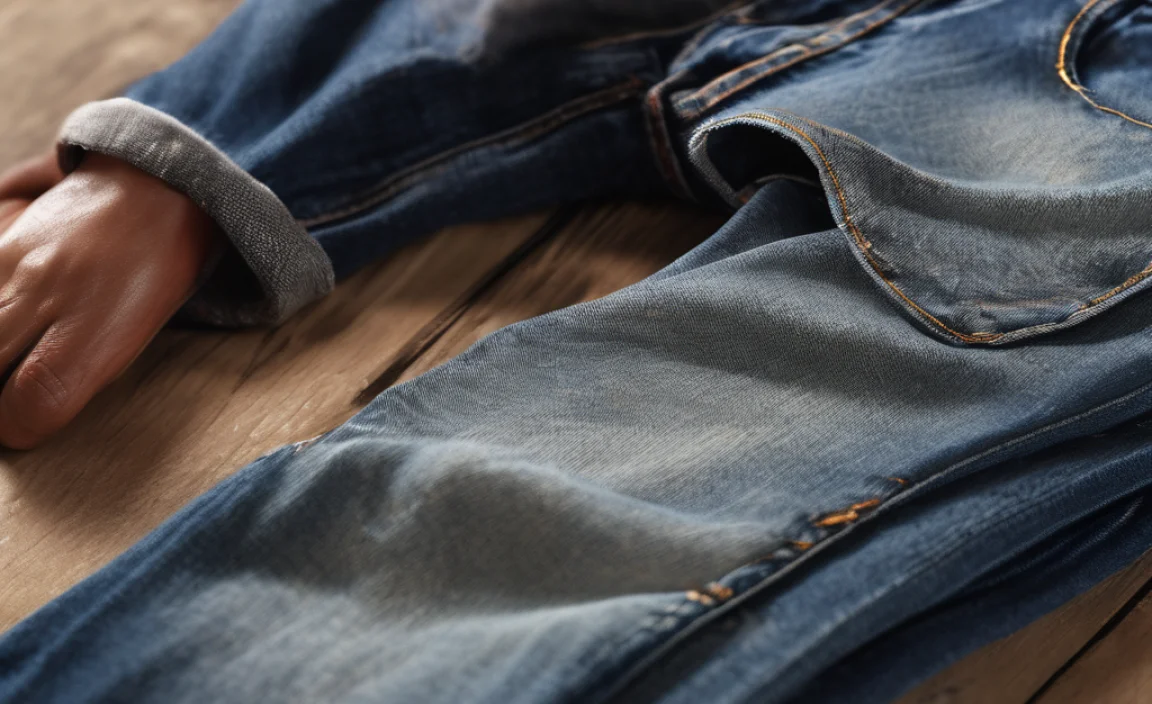Quick Summary: Easily remove fish sauce from your jeans by acting fast. Start with cold water and mild detergent, then pre-treat tough stains with a paste of baking soda and water, or a delicate enzyme cleaner, before washing as usual. Always air dry first to ensure the stain is gone.
Oh no, the dreaded fish sauce stain! It happens to the best of us, whether you’re enjoying a delicious Vietnamese pho or preparing a favorite stir-fry. That pungent aroma and stubborn stain can seem daunting, especially on your favorite pair of jeans. But don’t worry, with a few simple steps and the right approach, you can banish that fish sauce smell and stain for good. We’ll walk you through exactly how to tackle this common laundry mishap, leaving your denim fresh and clean.
The Science Behind Fish Sauce Stains and Smells

Fish sauce is a potent condiment made from fermented anchovies and salt. Its strong odor and staining power come from its high protein content and the compounds released during the fermentation process. These proteins can bind to fabric fibers, making them difficult to remove with just water. The smell, often described as ammoniated or intensely “fishy,” is due to the breakdown of amino acids and other nitrogenous compounds. Understanding this helps us choose the right cleaning agents that can break down these proteins and neutralize the odor.
When fish sauce encounters fabric, especially absorbent materials like denim, it can seep into the weave. If left untreated, these stains can set, becoming much harder to lift. The smell can also linger, making your clothes unpleasant to wear. Fortunately, tackling these stains is a manageable process with a few key strategies.
Immediate Action: The First Line of Defense

The most crucial factor in removing any stain, including fish sauce, is how quickly you act. The longer the stain sits on your jeans, the more deeply it will penetrate the fabric fibers, making removal more challenging.
Step 1: Blot, Don’t Rub
As soon as you notice the spill, grab a clean cloth, paper towel, or even a napkin. Gently blot the affected area. The goal here is to absorb as much of the excess fish sauce as possible without spreading it further or pushing it deeper into the denim. Rubbing will only make the stain larger and harder to treat.
Step 2: Cold Water Rinse
Once you’ve blotted up the excess, turn the jeans inside out and rinse the stained area from the back with cold water. This helps to push the stain out of the fabric rather than further in. Avoid hot water, as it can actually set protein-based stains like fish sauce, making them permanent.
Pre-Treatment Solutions: Tackling Stubborn Stains

If the cold water rinse alone doesn’t completely remove the stain or odor, it’s time for pre-treatment. There are several effective methods you can try using common household items.
Method 1: Mild Detergent Paste
A simple paste made from your regular laundry detergent and a little water can be very effective.
- Mix a small amount of liquid laundry detergent with water to form a thick paste.
- Gently rub this paste into the stained area using your fingers or a soft brush.
- Let it sit for about 10-15 minutes to allow the detergent to work on breaking down the stain.
- Rinse the area thoroughly with cold water.
Method 2: Baking Soda Paste
Baking soda is a natural deodorizer and a mild abrasive, making it excellent for lifting both stains and odors.
- Create a paste by mixing baking soda with enough water to achieve a thick consistency.
- Apply the paste generously to the stained area.
- Let it sit for at least 30 minutes, or even a few hours for tougher stains.
- Gently brush off the dried paste and rinse the area with cold water.
Method 3: Enzyme Cleaner
Enzyme cleaners are specifically designed to break down organic stains, including proteins, fats, and oils. They are highly effective against fish sauce.
- Choose a laundry-safe enzyme cleaner. You can find these in most grocery stores or online. Look for products specifically designed for protein or organic stains. Websites like the U.S. Environmental Protection Agency’s Safer Choice program can help you find environmentally friendly cleaning options.
- Follow the product instructions carefully. Typically, you’ll apply the cleaner directly to the stain, let it soak for a specified amount of time (usually 15-30 minutes), and then proceed to wash.
- Ensure the cleaner is suitable for denim before using.
Method 4: White Vinegar Solution
White vinegar is another excellent natural deodorizer and stain remover.
- Mix equal parts white vinegar and cold water.
- Apply the solution to the stain and let it soak for about 15-30 minutes.
- Gently work the solution into the fabric.
- Rinse thoroughly with cold water.
Washing Your Jeans

After pre-treating, it’s time to wash your jeans to remove any remaining traces of the stain and odor.
Step 1: Check the Care Label
Always check the care label on your jeans for specific washing instructions. This will tell you the recommended water temperature, cycle, and any other special care requirements.
Step 2: Wash in Cold Water
Wash your jeans in cold water. As mentioned, hot water can set protein stains. Use your regular laundry detergent, and consider adding a laundry booster or an oxygen-based bleach (if safe for your denim color) for extra stain-fighting power.
Step 3: Consider Adding a Deodorizer
If you’re concerned about lingering odor, you can add a cup of baking soda or a half cup of white vinegar to the wash cycle along with your detergent. Make sure to add them separately: baking soda directly into the drum and vinegar into the fabric softener compartment (or add it during the rinse cycle).
The Crucial Drying Step

This is a step many people overlook, and it’s vital for ensuring the fish sauce stain is completely gone.
Step 1: Air Dry First
Once the wash cycle is complete, resist the temptation to put your jeans in the dryer. Instead, air dry them. This allows you to inspect the stained area carefully once it’s dry. If you put them straight into the dryer, the heat can set any remaining stain, making it very difficult to remove later.
Step 2: Inspect and Repeat if Necessary
Once your jeans are completely air-dried, hold the fabric up to the light and inspect the previously stained area. If you can still see any trace of the stain or detect any residual odor, repeat the pre-treatment and washing steps. You might need to try a different pre-treatment method or let the chosen method soak for longer.
Step 3: Machine Dry (Once Stain is Gone)
Only when you are absolutely certain the stain and odor are gone should you proceed to machine dry your jeans according to the care label. Using a dryer on a low heat setting is usually safe at this point.
Advanced Techniques and Alternative Methods
For particularly stubborn or old fish sauce stains, you might need to explore more intensive methods.
Using Oxygen Bleach
Oxygen bleach (like OxiClean) is a color-safe alternative to chlorine bleach and is very effective at lifting organic stains.
- Follow the package instructions for soaking or for adding to your wash cycle.
- For tough stains, create a paste of oxygen bleach and water and apply it directly to the stain before washing.
- Always test on an inconspicuous area of the jeans first to ensure colorfastness.
Hand Washing Specific Areas
Sometimes, focusing on the specific stained area during a hand wash can be more effective than a full machine wash.
- Fill a basin with cold water and a small amount of mild detergent.
- Submerge the stained portion of the jeans and gently agitate the fabric.
- Use a soft brush to work the detergent into the stain from both sides of the fabric.
- Let it soak for a while before rinsing thoroughly.
Professional Cleaning Advice
If your jeans are made of delicate material, are vintage, or the stain is particularly old and set, consider consulting a professional dry cleaner. They have access to specialized solvents and techniques that can often remove stains that are impossible to tackle at home.
Preventing Future Fish Sauce Stains
While accidents happen, a few simple precautions can help you avoid fish sauce stains in the future.
- Use Aprons: Always wear an apron when cooking with strong sauces or ingredients that are prone to splashing.
- Careful Pouring: When serving or cooking, pour fish sauce slowly and precisely to avoid drips.
- Clean Spills Immediately: Make it a habit to address spills the moment they happen, even small ones.
- Designated “Cooking Jeans”: If you frequently cook with ingredients that stain, consider having a dedicated pair of older jeans you don’t mind getting a little messy.
Table: Stain Removal Products Comparison
Here’s a quick look at common stain removal products and their suitability for fish sauce on jeans:
| Product | Pros | Cons | Best For |
|---|---|---|---|
| Mild Laundry Detergent | Readily available, gentle on fabric | May not be strong enough for set-in stains | Fresh stains, general pre-treatment |
| Baking Soda | Natural deodorizer, gentle abrasive, inexpensive | Can be slightly messy to apply | Neutralizing odor, lifting lighter stains |
| White Vinegar | Excellent deodorizer, effective stain lifter | Strong initial smell (dissipates when dry) | Removing odors, pre-treatment |
| Enzyme Cleaner | Specifically designed for protein stains, highly effective | Requires purchase of a specific product | Tough, set-in protein stains |
| Oxygen Bleach | Color-safe, powerful stain remover | Always test for colorfastness first | Stubborn stains on colored or white denim |
Frequently Asked Questions About Fish Sauce Stains on Jeans
Q1: Can I use regular bleach on fish sauce stains on my jeans?
A: It’s generally not recommended for colored jeans, as chlorine bleach can strip color and damage fibers. If your jeans are white, a diluted bleach solution might be an option, but oxygen bleach is a safer and more effective alternative for most fabrics and colors.
Q2: How long should I soak the stain before washing?
A: For fresh stains, 10-30 minutes for pre-treatment is often enough. For older or tougher stains, you might leave the pre-treatment paste or solution on for several hours, or even overnight, before washing. Always check the fabric’s durability and the product’s instructions.
Q3: My jeans still smell like fish sauce even after washing. What can I do?
A: Smells can be persistent. Try an overnight soak in a solution of cold water with a generous amount of baking soda or white vinegar. Then, rewash with a heavy-duty detergent, and add more baking soda or vinegar to the wash cycle. Ensure you air dry until the smell is completely gone.
Q4: Can I use a stain remover pen?
A: Stain remover pens can be helpful for immediate blotting and spot treatment on the go. However, for a deep-set or strong odor like fish sauce, they might not be powerful enough. It’s best to use them as a first step if you can’t wash the jeans immediately, and then follow up with a more robust method.
Q5: What is the best way to treat an old, set-in fish sauce stain on jeans?
A: For old stains, an enzyme cleaner or an oxygen bleach soak is usually most effective. You might need to repeat the treatment process multiple times. Soaking the affected area in the cleaner for several hours, or even overnight, can help break down the aged stain compounds.
Q6: My jeans are dark wash. Will these methods affect the color?
A: When using any pre-treatment or cleaning solution on dark wash jeans, it’s always wise to test on an inconspicuous area first, like an inside seam or the hem. Mild detergent, baking soda, and vinegar are generally safe. For oxygen bleach, ensure it’s specifically stated as color-safe.
When to Call in the Professionals
While most fish sauce stains on jeans are manageable with home remedies, there are a few situations where professional help is advisable:
- Delicate Denim: If your jeans are made of a very fine denim, have special finishes, or are embroidered, you might want to avoid home treatments to prevent damage.
- Vintage or Expensive Jeans: For valuable or sentimental pairs, the risk of error might be too high. A professional cleaner has expertise and specialized tools.
- Extremely Set-In Stains: If you’ve tried multiple home treatments and the stain or smell persists, a professional cleaner might have more potent solutions.
When consulting a professional, be sure to tell them exactly what the stain is (fish sauce) and what you’ve already tried. This information can help them select the most appropriate cleaning method.
Conclusion
Dealing with a fish sauce stain on your jeans can be a frustrating experience, but as you’ve seen, it’s far from a disaster. The key lies in promptly addressing the spill, using the right cleaning agents to break down the protein-based stain and neutralize the odor, and always air-drying to confirm the stain is gone before heat-setting it. By following these step-by-step guides and choosing the method that best suits your situation, you can restore your favorite jeans to their stain-free glory. Remember to check your jeans’ care label, be patient, and don’t be afraid to repeat the process if necessary. With a little care and attention, your denim will be back to looking and smelling fresh in no time!











